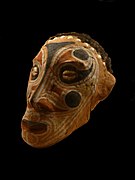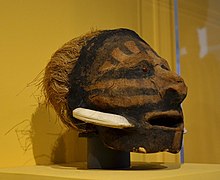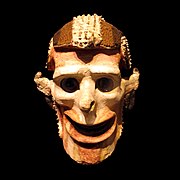Overmodelled skull
An overmodelled skull is a skull covered with various materials to reconstruct the appearance of a human head. This technique of art and religion is described in many countries throughout the ages.
Origins
A custom that has existed since the Neolithic era, it is widespread in Oceania and the Near East.[1] It originated as a cult of ancestors and consists of covering the dry skull with a plastic material, such as earth, clay, ash, plaster or lime.[2] Skulls can be embellished with pigments, jewellery etc. Sometimes, skulls of animals are also over-modelled.[3]
Gallery
 Overmodelled skull from Vanuatu.
Overmodelled skull from Vanuatu. Overmodelled skull, Vanuatu.
Overmodelled skull, Vanuatu._(8168058284).jpg) Skull in the musée du quai Branly.
Skull in the musée du quai Branly. Skull of the musée d'ethnographie de Genève, 19th.
Skull of the musée d'ethnographie de Genève, 19th._(39030812611).jpg) Overmodelled skull in Amman, neolithic era.
Overmodelled skull in Amman, neolithic era.
gollark: Oh, and it worked after a restart. Weird.
gollark: … why did Firefox on my phone seemingly randomly wipe its extensions and preferences?
gollark: Yep.
gollark: Never heard of it.
gollark: It's not really flaky as much as irritating to work on.
References
Articles annexes
Bibliography
- Alain Nicolas, Art papou, Nouvelles Éditions Scala, Paris, 2000 & L'art papou : Austronésiens et Papous de Nouvelle-Guinée (catalogue d'exposition, Musée de Marseille, 2000.
- Maxime Rovere, Magali Melandri, Rouge kwoma : peintures mythiques de Nouvelle-Guinée : exposition, Paris, Musée du quai Branly, 14 octobre 2008-4 janvier 2009, Réunion des musées nationaux : Musée du quai Branly, Paris, 2009, ISBN 978-2-915133-93-6.
- Objets de pouvoir en Nouvelle-Guinée (in French). Saint-Germain-en-Laye: Réunion des musées nationaux : musée d'Archéologie nationale. 2006.
- Anthony JP Meyer, Oceanic Art, Könemann, 1995.
- Arthur C. Aufderheide, Overmodeled Skulls, Heide Press, 2009
This article is issued from Wikipedia. The text is licensed under Creative Commons - Attribution - Sharealike. Additional terms may apply for the media files.